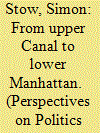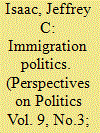|
|
|
Sort Order |
|
|
|
Items / Page
|
|
|
|
|
|
|
| Srl | Item |
| 1 |
ID:
116449


|
|
|
|
|
| Publication |
2012.
|
| Summary/Abstract |
The New Orleans Katrina Memorial is located at the upper end of Canal Street, an inexpensive and relatively short trolley car ride from the city's tourist hub in the French Quarter. Despite its ease of access, and close proximity to the more famous cemeteries to which tourists regularly make pilgrimage, the memorial is little visited and largely unknown, even to many of the city's own residents. In this it stands in stark contrast to the National September 11 Memorial in Lower Manhattan, which drew its millionth visitor less than four months after its opening on September 12, 2011. Recent work in political theory on memory, mourning, and memorialization-as well as Ancient Greek concerns about the same-point to the ways in which the manner of remembrance, grieving, and commemoration employed by a democratic polity help to shape political outcomes. In what follows, I trace the history and design of the New York City and New Orleans memorials to suggest the ways in which they embody and perpetuate national strategies of remembrance and forgetting, in which injustices perpetrated against the polity are prioritized over injustices perpetrated within it. Drawing on John Bodnar's distinction between national and vernacular commemoration, I nevertheless conclude with a counter-intuitive suggestion: that while on a national level the public's relative ignorance of the Katrina Memorial is indeed indicative of a polity more concerned with injustices perpetrated against it than within it; on a local level the erection and subsequent forgetting of the Katrina Memorial is a manifestation of a mode of vernacular memory, mourning and commemoration with far more democratically-productive potential than its counterpart in New York City. In particular, I argue that it cultivates, and historically has cultivated, a more forward-looking, progressive, and polyphonic response to loss than the type of dominant national narratives embodied by the 9/11 Memorial. Whereas the latter continually replays the loss in ways that rob the polity of its capacity to move beyond its initial response, the former acknowledges and incorporates the loss while steeling the community for the challenges ahead.
|
|
|
|
|
|
|
|
|
|
|
|
|
|
|
|
| 2 |
ID:
125144


|
|
|
|
|
| Publication |
2013.
|
| Summary/Abstract |
Using New York City as an example, this essay examines how American cities that have a long and continuous history of absorbing immigrants develop welcoming institutions and policies for current immigrants and their children. Cities such as Chicago, San Francisco, and New York have been gateway cities for many previous waves of immigrants and continue to absorb new immigrants today. The ethnic conflicts and accommodations of the nineteenth and twentieth centuries continue to shape the context of reception of today's immigrants. In contrast to "new destinations," which in recent years have often been centers of anti-immigrant sentiment and nativist local social policies, New York has generally adopted policies designed to include and accommodate new immigrants, as well as repurposing institutions that served earlier European immigrants and native-born African Americans and Puerto Ricans. The continuing significance of race in the city is counterbalanced in the lives of immigrants by a relative lack of nativism and an openness to incorporating immigrants.
|
|
|
|
|
|
|
|
|
|
|
|
|
|
|
|
| 3 |
ID:
110949


|
|
|
|
|
| Publication |
2011.
|
| Summary/Abstract |
"You are a Greek Jew? I thought all Greeks were Orthodox?" As a Jewish-American growing up in New York City, whose paternal grandparents were Jews who had emigrated from Greece in the 1920s, I was frequently asked this question by well-meaning-if confused-friends and acquaintances. Indeed, while "Greek Jew" has always been a central aspect of my multiply-hyphenated American identity, in fact my grandfather Morris Isaac, né Izaki, was from Salonika and, it turns out, he himself grew up as a Turkish Jew under the Ottoman Empire, only to discover after World War I that he was in fact (now) not a Turkish but a Greek Jew (which was not, in the parlance of his time, synonymous with being an authentic "Greek"). Greek (Orthodox) or Jewish? Greek or Turkish? Pogroms, wars, "ethnic cleansings," and sometimes even genocides have been undertaken to resolve such questions, and indeed my ancestors experienced all of these things in the opening decades of the twentieth century. For my family, such traumas are part of the story of how my grandparents came to leave Greece and migrate to the US and become Americans and US citizens (alas, many of their relatives were not able to leave, and most ultimately perished at the hands of the Nazis).
|
|
|
|
|
|
|
|
|
|
|
|
|
|
|
|
| 4 |
ID:
130853


|
|
|
| 5 |
ID:
107460


|
|
|
|
|
| Publication |
2011.
|
| Summary/Abstract |
Native air sampling (NAS) is distinguished from dedicated air sampling (DAS) devices (eg, BioWatch) that are deployed to detect aerosol disseminations of biological threat agents. NAS uses filter samples from heating, ventilation, and air conditioning (HVAC) systems in commercial properties for environmental sampling after DAS detection of biological threat agent incidents. It represents an untapped, scientifically sound, efficient, widely distributed, and comparably inexpensive resource for postevent environmental sampling. Calculations predict that postevent NAS would be more efficient than environmental surface sampling by orders of magnitude. HVAC filter samples could be collected from pre-identified surrounding NAS facilities to corroborate the DAS alarm and delineate the path taken by the bioaerosol plume. The New York City (NYC) Native Air Sampling Pilot Project explored whether native air sampling would be acceptable to private sector stakeholders and could be implemented successfully in NYC. Building trade associations facilitated outreach to and discussions with property owners and managers, who expedited contact with building managers of candidate NAS properties that they managed or owned. Nominal NAS building requirements were determined; procedures to identify and evaluate candidate NAS facilities were developed; data collection tools and other resources were designed and used to expedite candidate NAS building selection and evaluation in Manhattan; and exemplar environmental sampling playbooks for emergency responders were completed. In this sample, modern buildings with single or few corporate tenants were the best NAS candidate facilities. The Pilot Project successfully demonstrated that in one urban setting a native air sampling strategy could be implemented with effective public-private collaboration.
|
|
|
|
|
|
|
|
|
|
|
|
|
|
|
|
|
|
|
|
|